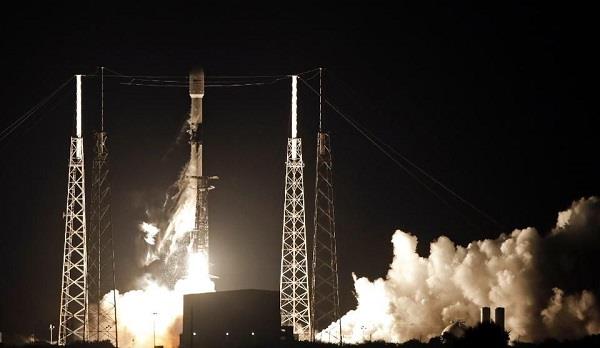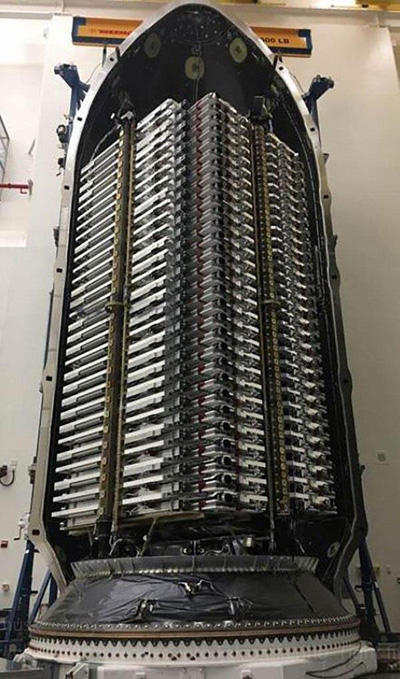SpaceX Launches First Starlink Satellites In Space Internet Battle
2019-05-27 / Number of views:1194

A Falcon 9 SpaceX rocket, with a payload of 60 satellites for SpaceX‘s Starlink broadband network, lifts off from Space Launch Complex 40 at the Cape Canaveral Air Force Station in Cape Canaveral, Fla., Thursday, May 23, 2019. (AP Photo/John Raoux)
SpaceX has successfully launched its first batch of Starlink satellites, a planned satellite mega constellation that aims to provide internet from space to billions of unconnected people around the world.
At 10:30pm Eastern time Thursday, a SpaceX Falcon 9 rocket lifted off from Cape Canaveral in Florida with 60 Starlink satellites on board, the first satellites designed to work within this constellation. SpaceX had launched two test satellites before, but today’s launch will be an important step towards eventually launching and operating 12,000 satellites in orbit to beam internet to the ground by the 2020s.
SpaceX had planned to perform this launch last week, but a software issue and high winds caused delays and led to the launch being pushed back to Thursday.
Eight minutes after the launch, the first stage of the rocket successfully landed on the drone ship Of Course I Still Love You (OCISLY) in the Atlantic Ocean. This was the third flight for the first stage booster, having flown on the Telsat 18 VANTAGE mission in September 2018, and the Iridium-8 mission in January 2019.
About an hour after the launch, the Starlink satellites will be deployed at an altitude of 440 kilometers, with their altitude later being raised to 550 kilometers with their onboard ion thrusters powered by krypton. It’s unclear how long they will remain in orbit, or how they will operate, although SpaceX did release some limited information prior to the launch.
“With a flat-panel design featuring multiple high-throughput antennas and a single solar array, each Starlink satellite weighs approximately 227 kilograms,” they said. “Importantly, Starlink satellites are capable of tracking on-orbit debris and autonomously avoiding collision.”
With 60 satellites on board and at 227 kilograms per satellite, this is SpaceX’s heaviest launch to date at about 13,620 kilograms. And this could herald the start of an ambitious launch program that will see dozens of launches take similarly-sized batches of Starlink satellites into orbit.

Elon Musk tweeted a picture of the Starlink satellites stacked inside the Falcon 9‘s payload fairing last week。ELON MUSK/SPACEX/TWITTER
SpaceX ultimately plans for Starlink to provide high-speed satellite internet across Earth around the clock, even as remote as Antarctica. Currently, satellite internet services are generally limited to a single country, with relatively low speeds and bandwidth limits that prevent the services from competing with their Earth-based equivalents.
According to CEO Elon Musk, SpaceX needs six more launches to begin the service, and a further six needed to begin "significant coverage" around most of Earth. SpaceX will operate its satellites at altitudes of 500 kilometers and 1,200 kilometers.
Although the company hasn’t yet revealed its pricing for how much their service will cost, Musk has made no secret that Starlink is designed to fund SpaceX’s ultimate goal of sending humans to Mars.
It’s estimated that 4 billion people in the world remain unconnected to the internet, some because they can’t afford it and others because they don’t have an available service. SpaceX is hoping to tap into these unconnected users and provide global internet to existing users too, to drum up funds. Musk said they had enough capital to launch enough satellites to get the service up and running.
Concerns have been raised, however, about the number of satellites being launched. SpaceX is one of nine companies that have been approved by the Federal Communications Commission (FCC) in the US to launch large constellations of satellites to provide internet services, totaling about 15,000 satellites across all nine. Other companies have plans for constellations too, such as Amazon and its 3,000-strong Project Kuiper, although they do not yet have FCC approval.
The risk of launching so many satellites is that it could cause significant space junk problems. Currently in orbit there are only 2,000 active satellites, with just 8,000 or so having been launched since Sputnik 1 reached orbit in 1957. These planned mega constellations will dramatically increase the number of satellites in orbit, with the risk of satellite failures also ever-present.
SpaceX and others will need to prove they can operate sustainably, including deorbiting their satellites in a timely manner, to keep Earth orbit clear of debris. Some, like OneWeb, another competitor in the space internet race, plan to attach grapple fixtures to their satellites so they can be deorbited in case of failure.
Earlier this week Musk had also suggested in a press conference prior to the launch that some of these first Starlink satellites could fail. Despite being designed to autonomously avoid other satellites in orbit, there are worries about launching so many satellites with some at risk of failure, both now and when thousands of these satellites will be in orbit.
Despite these concerns, SpaceX’s launch today places them one of the frontrunners in the space internet race. OneWeb launched its first operational satellites earlier this year, with other companies expected to follow suit. It’s unclear if there is a market for so many different satellite internet operators, so getting first to market could be key to ensure success.
But it will be imperative that concerns about launching so many satellites, and removing them from orbit (the United Nations asks operators to do so within 25 years), are addressed as early as possible. Vastly increasing the number of satellites in orbit carries complications, and SpaceX would do well to set a good example that other companies also adhere to.
- navigation
- Categories
- Contact
Add: 6F,building 5,CEC Park,Caotan 10th road,Xi'an,China
Post Code:710018
Tel: +86-29-88868880 Fax: +86-29-89348169
E-mail:info@satpro.com
Germany
Add: Dorftr. 1i, 16761, Hennigsdorf, Brandenburg, Germany
Tel: +4933022079295
- QR CODE

NEEQ:831244






